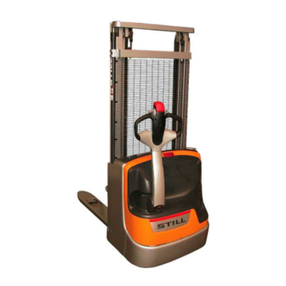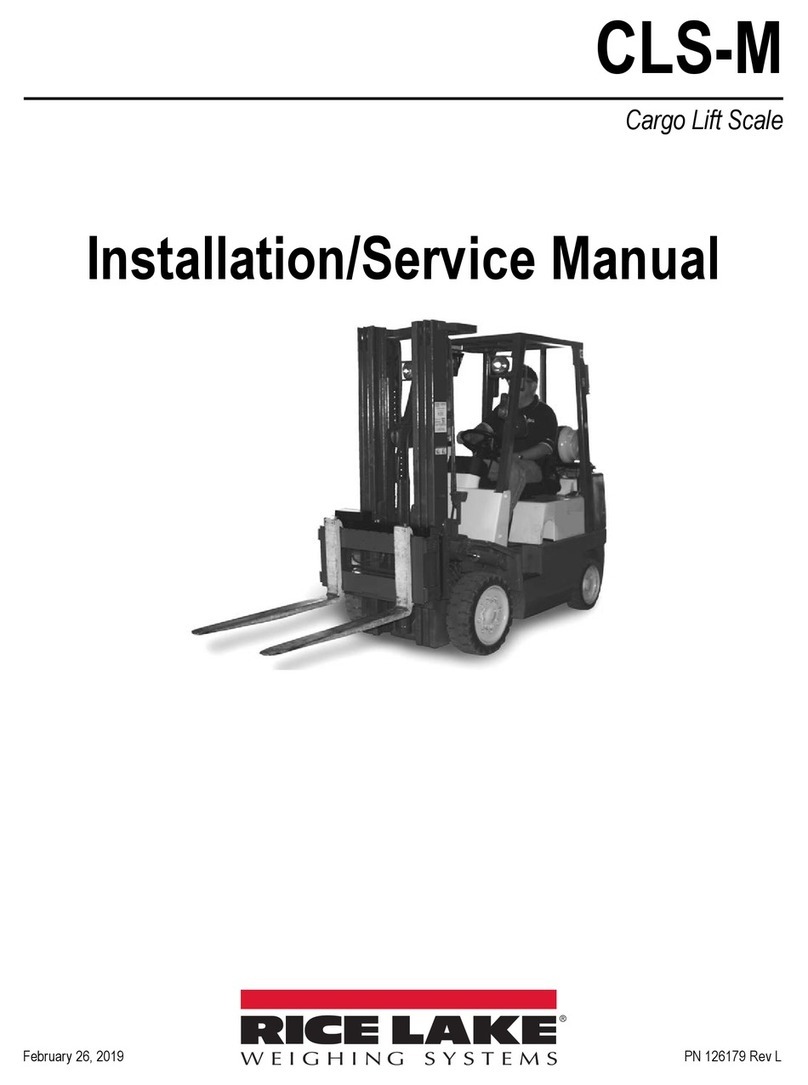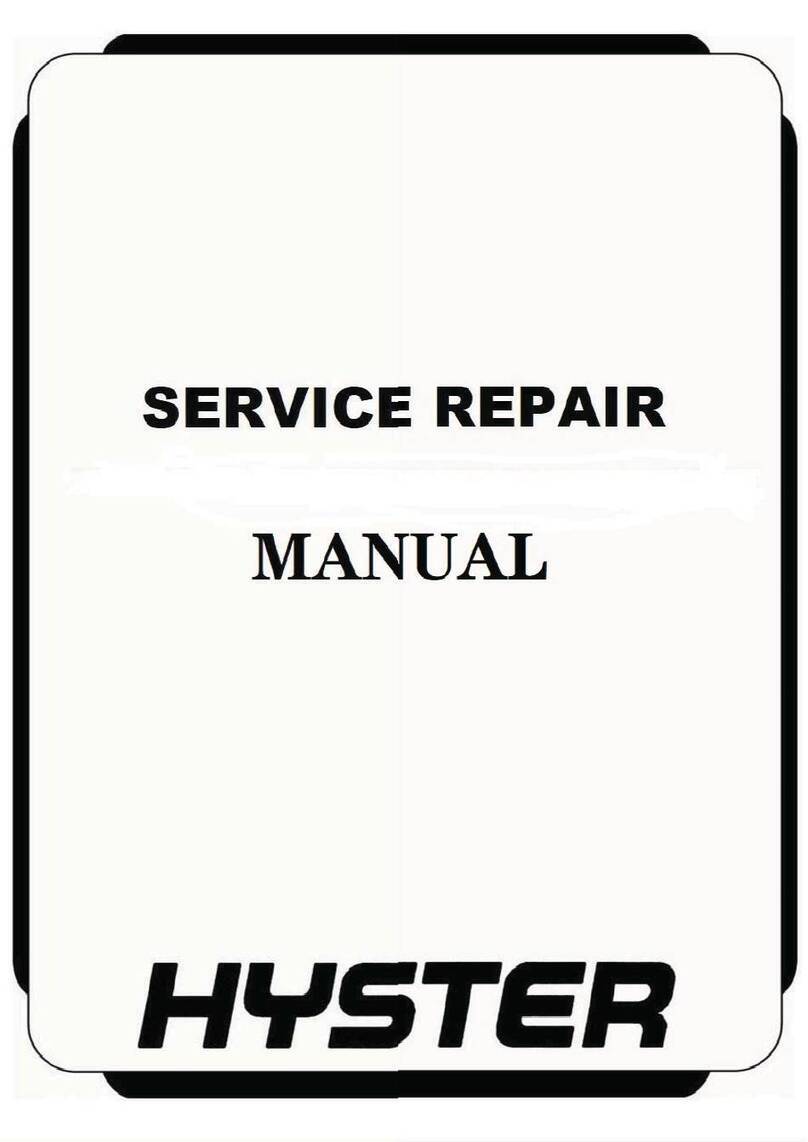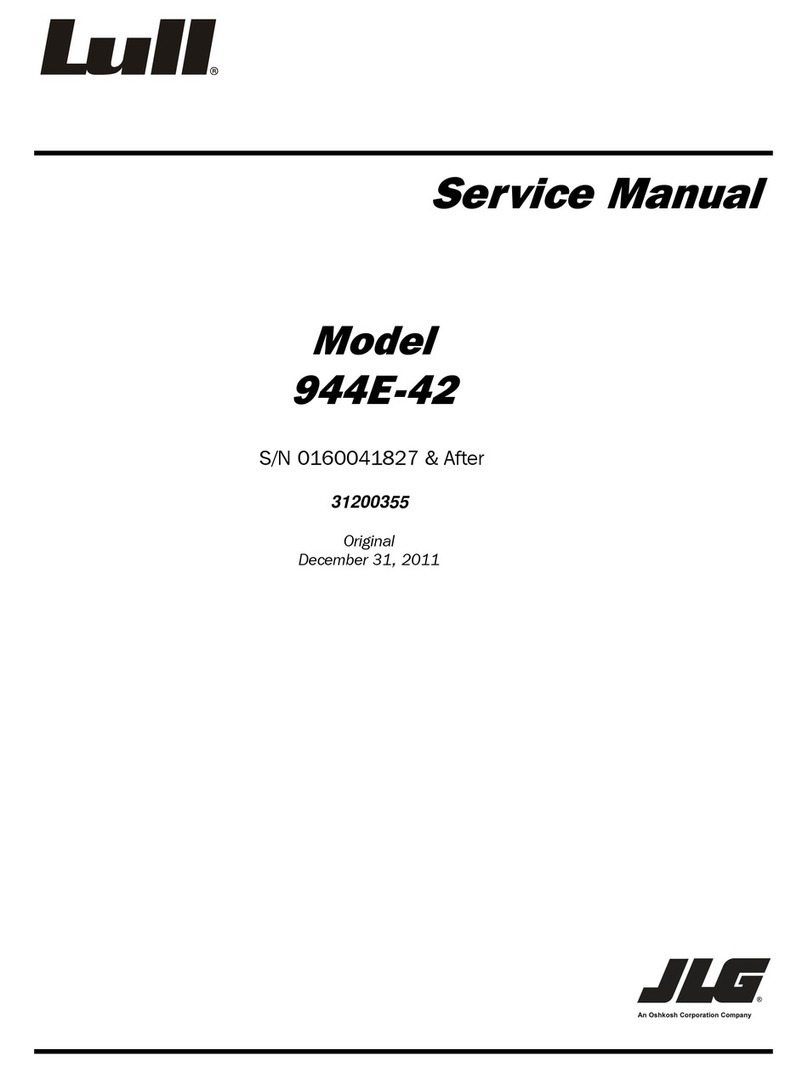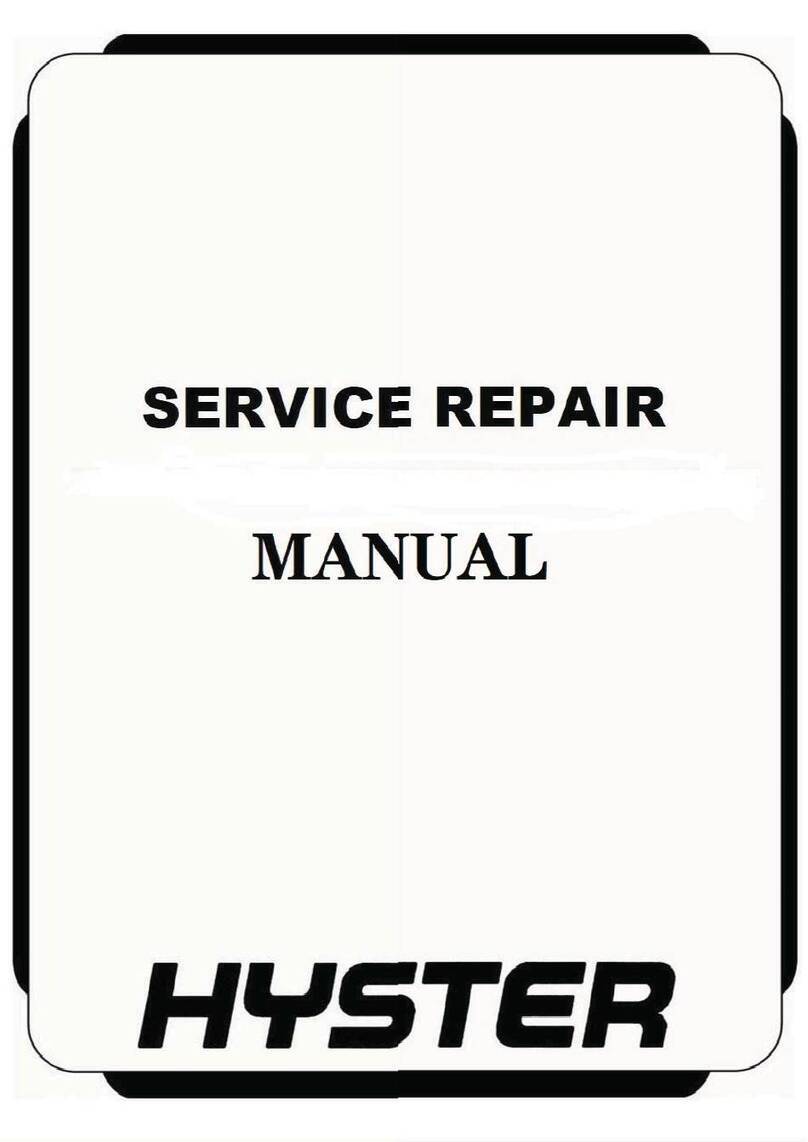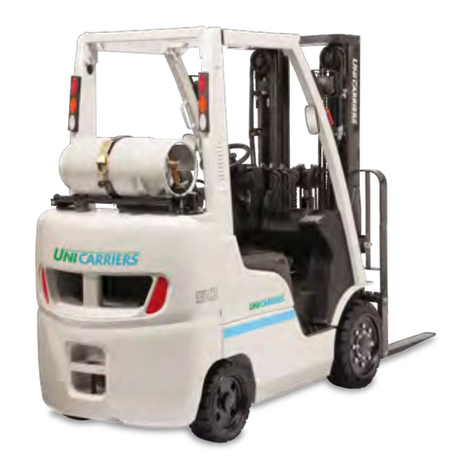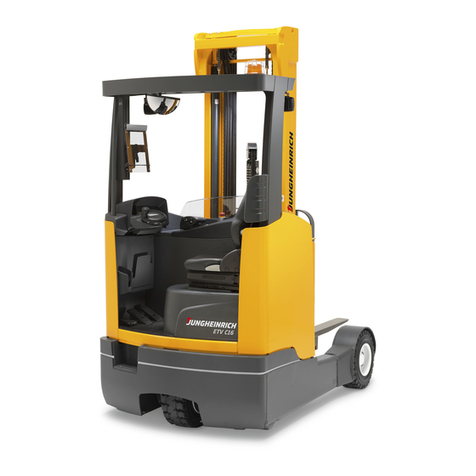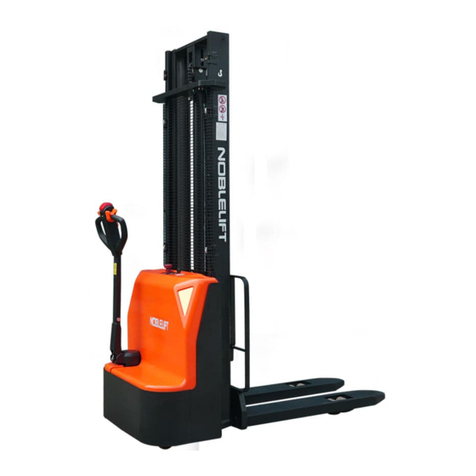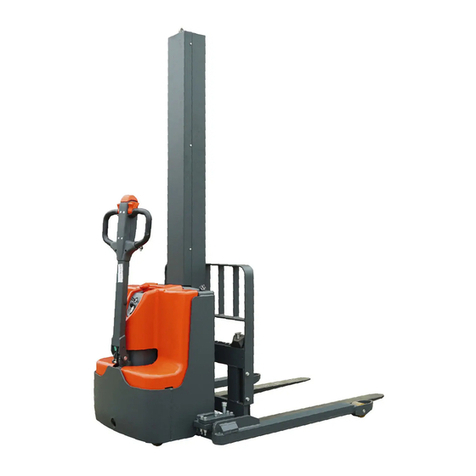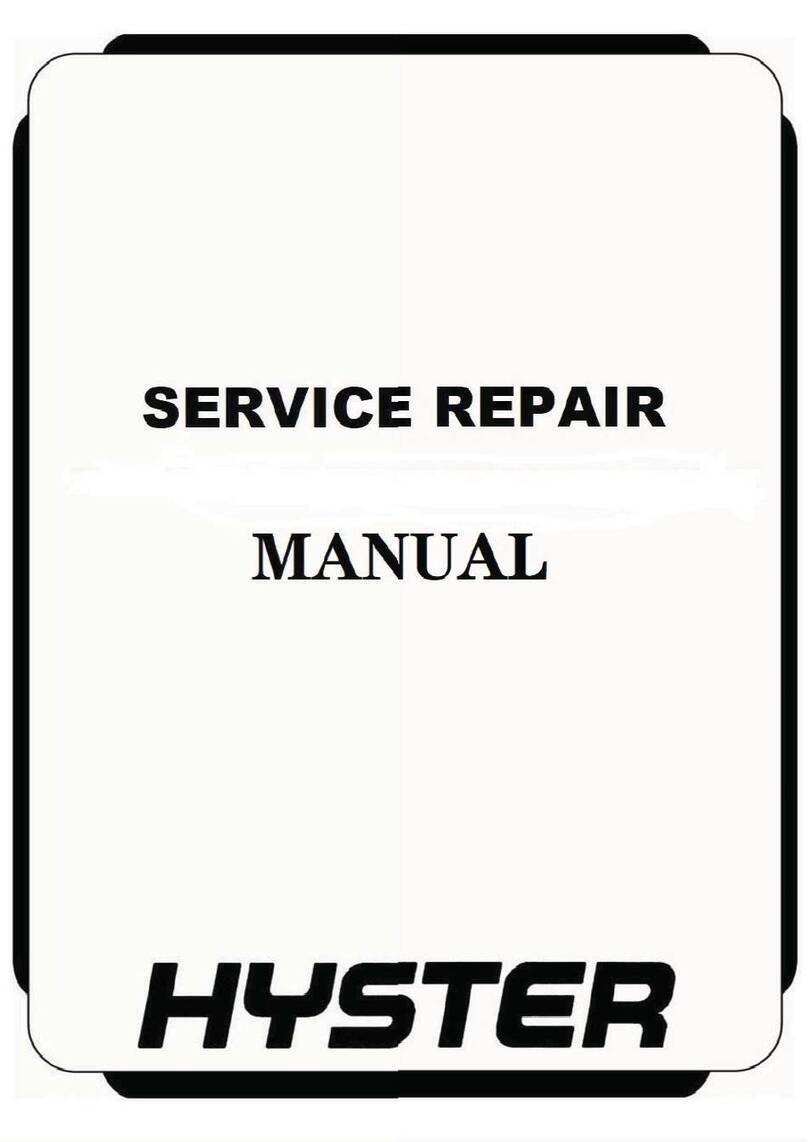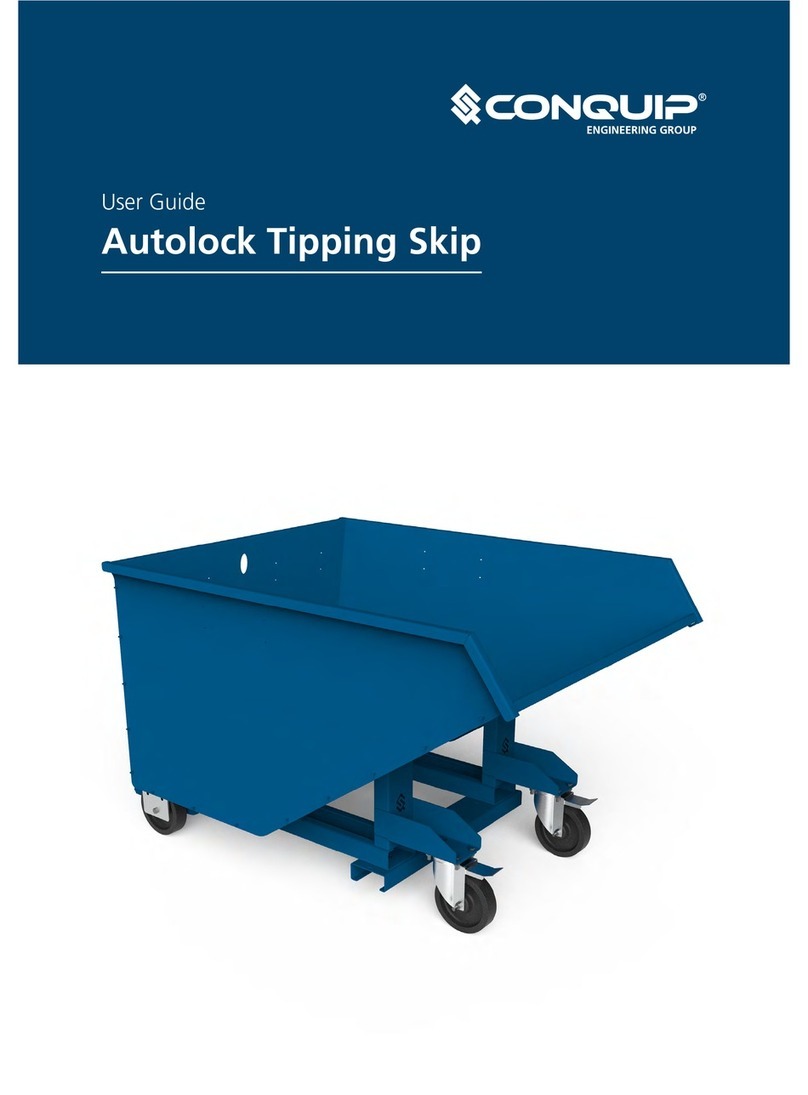Big Lift Big Joe PDC Series Use and care manual

Big Lift LLC MANUAL NO. 902997
www.bigjoeforklifts.com 02/05/2014
PDC SERIES
POWER DRIVEN
COUNTERBALANCED
LIFT TRUCK
Serial Number 384041 and Higher
Operation
Maintenance
Repair Parts List


902997 i
TABLE OF CONTENTS
Section Page Section Page
1 DESCRIPTION...........................................................1-1
1-1. INTRODUCTION..............................................1-1
1-2. GENERAL DESCRIPTION...............................1-1
1-3. SAFETY FEATURES. ......................................1-1
1-4. OPTIONS AND ACCESSORIES......................1-2
1-5. SAFETY SYMBOLS.........................................1-2
2 OPERATION ...............................................................2-1
2-1. GENERAL. .......................................................2-1
2-2. OPERATING PRECAUTIONS. ........................2-1
2-3. BEFORE OPERATION.....................................2-2
2-4. INSTRUMENTS AND CONTROLS..................2-4
2-4.1. STEERING ARM AND CONTROL HEAD........2-4
2-4.2. LIFT/LOWER AND TILT CONTROL. ...............2-5
2-4.3. BATTERY DISCONNECT................................2-5
2-4.4. OPTIONAL FEATURES...................................2-5
2-5. OPERATION ....................................................2-5
2-5.1. FORWARD AND REVERSE TRAVEL AND
SPEED CONTROL...........................................2-5
2-5.2. STEERING.......................................................2-5
2-5.3. STOPPING.......................................................2-6
2-5.4. PARKING. ........................................................2-6
2-5.5. BATTERY CHARGING.....................................2-7
2-5.6. LOAD HANDLING............................................2-7
2-5.7. MOVING A DISABLED TRUCK .......................2-7
3 PLANNED MAINTENANCE ........................................3-1
3-1. GENERAL. .......................................................3-1
3-2. MONTHLY AND QUARTERLY CHECKS. .......3-1
3-3. BATTERY CARE..............................................3-1
3-3.1. GENERAL. .......................................................3-1
3-3.2. BATTERY SERVICING....................................3-1
3-4. LUBRICATION. ................................................3-2
4 TROUBLESHOOTING ................................................4-1
4-1. GENERAL ........................................................4-1
5 STEERING ARM AND CONTROL
HEAD SERVICING......................................................5-1
5-1. GENERAL. .......................................................5-1
5-2. COLD CONDITIONING....................................5-1
5-3. BELLY-BUTTON SWITCH ADJUSTMENT......5-2
5-4. POTENTIOMETER TESTING AND
ADJUSTMENT .................................................5-2
5-5. CONTROL HEAD SWITCH REPLACEMENT..5-3
5-6. SPEED CONTROL SWITCH AND RETURN
SPRING REPLACEMENT................................5-5
5-7. STEERING ARM RETURN SPRING
ADJUSTMENT. ................................................5-6
5-8. STEERING ARM RETURN SPRING
REPLACEMENT...............................................5-6
5-9. PIVOT TUBE REPLACEMENT........................5-7
5-10. ELECTRICAL CONTROL CABLE
REPLACEMENT...............................................5-8
6 BRAKE SERVICING....................................................6-1
6-1. ADJUSTMENT .................................................6-1
6-2. REPLACEMENT OF BRAKE PADS.................6-2
6-2.1. REPLACEMENT OF BRAKE DISC..................6-4
7 TRANSMISSION, DRIVE WHEEL AND
LOAD WHEEL SERVICING........................................7-1
7-1. TRANSMISSION REMOVAL AND
DISASSEMBLY................................................7-1
7-2. DRIVE WHEEL REPLACEMENT.....................7-3
7-3. LOAD WHEELS. ..............................................7-3
8 ELEVATION SYSTEM SERVICING........................... 8-1
8-1. GENERAL........................................................ 8-1
8-2. LIFT CHAIN ADJUSTMENT
(NON-TELESCOPIC, AND TELESCOPIC)..... 8-1
8-3. LIFT CHAIN ADJUSTMENT
(FULL FREE LIFT)........................................... 8-2
8-4. LIFT CHAIN ADJUSTMENT
(CLEAR VIEW TRIMAST) ............................... 8-3
8-4.1. FULL FREE LIFT CHAIN................................. 8-3
8-4.2. SECONDARY LIFT CHAINS........................... 8-3
8-5. LIFT CHAIN INSPECTION .............................. 8-4
8-6. LIFT CHAIN REPLACEMENT
(NON-TELESCOPIC, AND TELESCOPIC)..... 8-4
8-7. LIFT CHAIN REPLACEMENT
(FULL FREE LIFT)........................................... 8-4
8-8. LIFT CHAIN REPLACEMENT
(CLEAR VIEW TRIMAST) ............................... 8-4
8-8.1. FULL FREE LIFT CHAIN................................. 8-4
8-8.2. SECONDARY LIFT CHAINS........................... 8-4
8-9. LIFT CYLINDER REPLACEMENT
(NON-TELESCOPIC, AND TELESCOPIC)..... 8-5
8-10. LIFT CYLINDER REPLACEMENT
(FULL FREE LIFT)........................................... 8-5
8-11. LIFT CYLINDER REPLACEMENT
(CLEAR VIEW TRIMAST) ............................... 8-6
8-11.1.FULL FREE LIFT CYLINDER.......................... 8-6
8-11.2.SECONDARY LIFT CYLINDERS.................... 8-6
8-12. TILT CYLINDER REPLACEMENT. ................. 8-6
8-13. HOSE BRACKET REPLACEMENT............... 8-10
8-14. MAST REMOVAL. ......................................... 8-10
8-15. LIFT CARRIAGE REPLACEMENT................ 8-10
9 HYDRAULIC SYSTEM SERVICING........................... 9-1
9-1. RELIEVING SYSTEM PRESSURE................. 9-1
9-2. LINE, FITTING AND HOSE REPLACEMENT. 9-1
9-2.1. STANDARD TRUCKS. .................................... 9-1
9-3. FILTER REPLACEMENT. ............................. 9-10
9-3.1. SUMP FILTER............................................... 9-10
9-4. HYDRAULIC PUMP AND
MOTOR ASSEMBLY..................................... 9-11
9-5. CONTROL VALVE REPLACEMENT............. 9-12
9-6. FLOW CONTROL VALVE REPLACEMENT
(NON-TELESCOPIC AND TELESCOPIC).... 9-13
9-6.1. LIFT FLOW CONTROL VALVE..................... 9-13
9-6.2. TILT FLOW CONTROL VALVE..................... 9-13
9-7. LIFT CYLINDER REPAIR.............................. 9-14
9-7.1. NON-TELESCOPIC, TELESCOPIC AND
CLEAR VIEW TRIMAST................................ 9-14
9-7.2. FULL FREE LIFT........................................... 9-15
9-8. TILT CYLINDER REPAIR.............................. 9-16
9-8.1. BMP MODEL CYLINDER.............................. 9-16
9-8.2. CH MODEL CYLINDER................................. 9-17
9-8.3. EM MODEL CYLINDER ................................ 9-18
10 ELECTRICAL COMPONENTS................................. 10-1
10-1. ELECTRICAL CONTROL PANELS............... 10-1
10-1.1.CLEANING .................................................... 10-1
10-1.2.PANEL REMOVAL. ....................................... 10-1
10-1.3.PANEL DISASSEMBLY................................. 10-1
10-1.4.CONTACTOR BOX DISASSEMBLY AND
REASSEMBLY (TYPE EE TRUCKS ONLY). 10-1
10-1.5.CONTACTOR SERVICING. .......................... 10-6
10-2. PUMP MOTORS............................................ 10-7
10-3. DRIVE MOTORS........................................... 10-7
10-4. BATTERIES................................................... 10-7
10-5. HIGH SPEED LIMIT SWITCH. ...................... 10-8

ii 902997
TABLE OF CONTENTS - Continued
Section Page Section Page
11 OPTIONAL EQUIPMENT ......................................... 11-1
11-1. KEYSWITCH.................................................. 11-1
11-2. HOUR METER............................................... 11-1
11-3. BATTERY CAPACITY INDICATOR............... 11-1
11-4. HAND HELD REMOTE CONTROL................11-1
11-5. AUXILIARY HYDRAULICS ............................11-1
12 ILLUSTRATED PARTS BREAKDOWN ....................12-1
LIST OF ILLUSTRATION
Figure Page Figure Page
1-1 NAME PLATE ..................................................... 1-1
1-2 PDC LIFT TRUCK............................................... 1-3
2-1 LOAD CENTER................................................... 2-1
2-2 SAMPLE OF OPERATOR CHECK LIST............ 2-3
2-3 CONTROL HANDLE........................................... 2-4
2-4 LIFT/LOWER CONTROL.................................... 2-5
2-5 OPTIONAL REMOTE LIFT/LOWER CONTROL 2-5
2-6 STEERING ARM BRAKING POSITION ............. 2-6
3-1 LUBRICATION DIAGRAM.................................. 3-3
4-1 ELECTRICAL SCHEMATIC................................ 4-6
4-2 ELECTRICAL SCHEMATIC ............................... 4-8
4-3 WIRING DIAGRAM .......................................... 4-10
4-4 WIRING DIAGRAM........................................... 4-12
4-5 WIRING DIAGRAM........................................... 4-16
5-1 SCHEMATIC OF COLD
CONDITIONING CIRCUIT.................................. 5-1
5-2 LOCATION OF RESISTORS AND
THERMAL CUTOUT SWITCH............................ 5-1
5-3 BELLY-BUTTON SWITCH ADJUSTMENT......... 5-2
5-4 CONTROL HEAD POTENTIOMETER
ADJUSTMENT.................................................... 5-3
5-5 CONTROL HEAD ASSEMBLY........................... 5-4
5-6 PUSH BUTTON SWITCHES, CONTROL HEAD 5-5
5-7 STEERING ARM................................................. 5-7
5-8 PIVOT TUBE REMOVAL TOOL ......................... 5-8
5-9 PIVOT TUBE BUSHING REPLACEMENT ......... 5-9
5-10 ELECTRICAL CONTROL CABLE
REPLACEMENT................................................. 5-9
6-1 BRAKE ENGAGE/DISENGAGE......................... 6-1
6-2 BRAKE ADJUSTMENT....................................... 6-2
6-3 BRAKE AND LINKAGE....................................... 6-3
7-1 TRANSMISSION ASSEMBLY ............................ 7-1
7-2 TRANSMISSION REMOVAL.............................. 7-2
7-3 LOAD WHEELS.................................................. 7-3
8-1 ELEVATION SYSTEM........................................ 8-1
8-2 ELEVATION SYSTEM........................................ 8-2
8-3 ELEVATION SYSTEM
(CLEAR VIEW TRIMAST)................................... 8-3
8-4 HYDRAULIC SYSTEM........................................ 8-7
8-5 HYDRAULIC SYSTEM
(CLEAR VIEW TRIMAST)................................... 8-8
8-6 INNER AND OUTER MASTS
(FULL FREE LIFT)............................................ 8-11
8-7 BASE AND FRAME .......................................... 8-12
9-1 HYDRAULIC SYSTEM
(NON-TELESCOPIC AND TELESCOPIC) ......... 9-2
9-2 HYDRAULIC SYSTEM
(NON-TELESCOPIC AND TELESCOPIC) ......... 9-3
9-3 HYDRAULIC SYSTEM (FFL).............................. 9-4
9-4 HYDRAULIC SYSTEM (FFL).............................. 9-5
9-5 HYDRAULIC SYSTEM
(CLEAR VIEW TRIMAST)................................... 9-6
9-6 HYDRAULIC SYSTEM........................................ 9-8
9-7 HYDRAULIC PANEL ASSEMBLY.................... 9-10
9-8 PUMP AND MOTOR......................................... 9-11
9-9 STANDARD CONTROL VALVE....................... 9-12
9-10 LIFT CYLINDER
(NON-TELESCOPIC AND TELESCOPIC)........ 9-14
9-11 LIFT CYLINDER ASSEMBLY
(FULL FREE LIFT) ............................................ 9-15
9-12 TILT CYLINDER................................................ 9-16
9-13 TILT CYLINDER................................................ 9-17
9-14 TILT CYLINDER................................................ 9-18
10-1 CONTROL PANEL ASSEMBLY (TYPE E)........ 10-2
10-2 CONTROL PANEL ASSEMBLY (TYPE EE)..... 10-3
10-3 CONTROL PANEL ASSEMBLY (TYPE E)........ 10-4
10-4 CONTROL PANEL ASSEMBLY (TYPE EE)..... 10-5
10-5 DOUBLE POLE CONTACTOR, FORWARD,
REVERSE ......................................................... 10-7
10-6 MAST RELATED ELECTRICAL
COMPONENTS................................................. 10-8
12-1 CONTROL HEAD ASSEMBLY.......................... 12-2
12-2 PUSH BUTTON SWITCHES,
CONTROL HEAD.............................................. 12-4
12-3 COLD CONDITIONING, CONTROL
HEAD ASSEMBLY............................................ 12-5
12-4 STEERING ARM............................................... 12-6
12-5 PIVOT TUBE ASSEMBLY................................. 12-8
12-6 BRAKE AND LINKAGE................................... 12-10
12-7 STANDARD TRANSMISSION ASSEMBLY.... 12-12
12-8 BASE & FRAME.............................................. 12-14
12-9 DECAL LOCATION......................................... 12-16
12-10 LOAD WHEELS............................................... 12-18
12-11 ELEVATION SYSTEM (NON-TELESCOPIC). 12-19
12-12 ELEVATION SYSTEM (NON-TELESCOPIC). 12-20
12-13 ELEVATION SYSTEM (TELESCOPIC) .......... 12-22
12-14 ELEVATION SYSTEM (TELESCOPIC) .......... 12-24
12-15 ELEVATION SYSTEM (FULL FREE LIFT) ..... 12-26
12-16 ELEVATION SYSTEM (FULL FREE LIFT) ..... 12-28
12-17 ELEVATION SYSTEM
(CLEAR VIEW TRIMAST)............................... 12-30
12-18 LIFT CARRIAGES........................................... 12-32
12-19 LIFT CARRIAGES........................................... 12-34
12-20 STANDARD CONTROL VALVE...................... 12-36
12-21 CONTROL VALVE .......................................... 12-38
12-22 VALVE SECTION............................................ 12-39
12-23 HYDRAULIC SYSTEM (NON TELESCOPIC
AND TELESCOPIC)........................................ 12-40
12-24 HYDRAULIC SYSTEM (NON TELESCOPIC
AND TELESCOPIC)........................................ 12-42
12-25 HYDRAULIC SYSTEM (FULL FREE LIFT)..... 12-44
12-26 HYDRAULIC SYSTEM (FULL FREE LIFT)..... 12-46
12-27 HYDRAULIC SYSTEM
(CLEAR VIEW TRIMAST)............................... 12-48
12-28 HYDRAULIC SYSTEM.................................... 12-52
12-29 REMOTE CONTROL OPTION
HYDRAULIC ASSEMBLIES............................ 12-56
12-30 REMOTE CONTROL OPTION
HYDRAULIC ASSEMBLIES............................ 12-58
12-31 HYDRAULIC PANEL ASSEMBLY................... 12-60
12-32 PUMP AND MOTOR....................................... 12-62
12-33 LIFT CYLINDER ASSEMBLY
(NON TELESCOPIC AND TELESCOPIC)...... 12-64

902997 iii
LIST OF ILLUSTRATION - Continued
Figure Page Figure Page
12-34 LIFT CYLINDER ASSEMBLY
(FULL FREE LIFT) .......................................... 12-66
12-35 SECONDARY LIFT CYLINDER (2 INCH)
(CLEAR VIEW TRIMAST) ............................... 12-68
12-36 FULL FREE LIFT LIFT CYLINDER (2.75 INCH)
(CLEAR VIEW TRIMAST) ............................... 12-69
12-37 TILT CYLINDER.............................................. 12-70
12-38 TILT CYLINDER.............................................. 12-71
12-39 TILT CYLINDER.............................................. 12-72
12-40 MAST RELATED ELECTRICAL
COMPONENTS............................................... 12-73
12-41 PUMP MOTOR................................................ 12-74
12-42 DRIVE MOTOR ............................................... 12-75
12-43 CONTROL PANEL ASSEMBLY (TYPE E)...... 12-76
12-44 CONTROL PANEL ASSEMBLY (TYPE EE)... 12-78
12-45 CONTROL PANEL ASSEMBLY (TYPE E)..... 12-80
12-46 CONTROL PANEL ASSEMBLY (TYPE EE)... 12-82
12-47 CONTACTOR, FORWARD, REVERSE ......... 12-84
12-48 DEAD-MAN BRAKE SWITCH ........................ 12-85
12-49 REMOTE CONTROL OPTION ....................... 12-86
12-50 OPTIONAL HOUR METER SWITCH
INSTALLATION .............................................. 12-88
12-51 BATTERY CAPACITY INDICATOR WIRING
DIAGRAMSYSTEMS WITHOUT LOCKOUT.. 12-90
12-52 BATTERY CAPACITY INDICATOR WIRING
DIAGRAM SYSTEMS WITH LOCKOUT ....... 12-91
12-53 OPTIONAL KEY SWITCH .............................. 12-92
LIST OF TABLES
Table Page Table Page
2-1 OPERATOR CHECKS ..........................................2-2
2-2 CONTROL HANDLES...........................................2-4
3-1 MONTHLY AND QUARTERLY INSPECTION
AND SERVICE CHART..........................................3-1
3-2 RECOMMENDED LUBRICANTS AND OILS........3-2
3-3 HYDRAULIC OIL CAPACITY CHART.................. 3-2
3-4 LUBRICATION CHART ........................................ 3-3
4-1 TROUBLESHOOTING CHART ............................ 4-1
10-1 ELECTRICAL CONTROL PANELS.................... 10-1

iv 902997
NOTES

902997 1

1-2 902997

902997 1

1-2 902997

902997 v
OPERATOR INSTRUCTIONS
WARNING
Do not operate this truck unless you have been trained
and authorized to do so and have read all warnings
and instructions in operator's manual and on this truck.
Do not operate this truck until you have checked its
condition. Give special attention to Tires, Horn, Lights,
Battery, Controller, Lift System, (including forks or
attachments, chains, cables and limit switches),
Brakes, Steering Mechanism, Guards and Safety
Devices.
Operate truck only from designated operating position.
Never place any part of your body into the mast struc-
ture or between the mast and the truck. Do not carry
passengers.
Observe applicable traffic regulations. Yield right of
way to pedestrians. Slow down and sound horn at
cross aisles and wherever vision is obstructed.
Start, stop, travel, steer and brake smoothly. Slow
down for turns and on uneven or slippery surfaces that
could cause truck to slide or overturn. Use special
care when traveling without load as the risk of overturn
may be greater.
Travel with lifting mechanism as low as possible.
Always look in direction of travel. Keep a clear view,
and when load interferes with visibility, travel with load
or lifting mechanism trailing, except when traveling
downhill.
Use special care when operating on ramps—travel
slowly, and do not angle or turn. Travel with lifting
mechanism or load downhill.
Do not overload truck. Check capacity plate for load
weight and load center information.
When using forks, space forks as far apart as load will
permit. Before lifting, be sure load is centered, forks
are completely under load, and load is far back as pos-
sible against load backrest.
Do not handle unstable or loosely stacked loads. Use
special care when handling long, high or wide loads to
avoid losing the load, striking bystanders, or tipping
the truck.
Do not handle loads which are higher than the load
backrest or load backrest extension unless load is
secured so that no part of it could fall backward.
Elevate forks or other lifting mechanism only to pick up
or stack a load. Watch out for obstructions, especially
overhead.
Do not lift personnel except on a securely attached
specially designed Work Platform. Use extreme care
when lifting personnel. Make sure mast is vertical,
place truck controls in neutral and apply brakes. Lift
and lower smoothly. Remain in operating position or
immediate vicinity as long as personnel are on the
Work Platform. Never transport personnel on forks or
Work Platform.
Do not allow anyone to stand or pass under load or lift-
ing mechanism.
When leaving truck, neutralize travel control. Fully
lower lifting mechanism and set brake. When leaving
truck unattended, also shut off power.
PREPARATION FOR USE
Upon receipt, visually inspect the truck. If any damage
is found, report it to the carrier and to your Big Joe
dealer immediately.
Remove cardboard banded to truck. Check lift truck for
scratches and dents. Check to make sure that the lift
chains are free of slack. Inspect for oil leaks and loose
wiring connections. Make certain that all accessories
and attachments that were ordered are supplied.
Before the lift truck is moved, the battery must be
checked, recharged if necessary, and connected.
Refer to “Battery Care” in Section III for battery check-
ing instructions.
Refer to SECTION 2 for operating instructions of
the brakes and lift control.
If you do not obtain the proper results, or if improper
operation occurs, refer to troubleshooting in SECTION
4.

vi 902997
NOTES

902997 1-1
SECTION 1
DESCRIPTION
1-1. INTRODUCTION.
This publication describes the Big Joe Power Driven
Counterbalanced (PDC) lift truck manufactured by Big
Lift, LLC. Included are operating instructions, planned
maintenance instructions, lubrication procedures, cor-
rective maintenance procedures and a complete parts
list with By following the recommendations contained
in this manual, you will receive many years of depend-
able service from your Big Joe lift truck.
The lift truck is identified by a model number. The
model number shows truck capacity, fork and mast
type, and lift height. A typical model number is
explained below.
The model number will be found on the name plate
(Figure 1-1) along with the serial number, lifting capac-
ity, and load center. Figure 1-2 shows the locations of
the trucks main components and controls.
Users shall comply with all requirements indicated in
applicable OSHA Standards and current edition of
A.N.S.I. B56.1 Part II. By following these requirements
and the recommendations contained in this manual,
you will receive many years of dependable service
from your Big Joe Lift Truck.
1-2. GENERAL DESCRIPTION.
The self-propelled PDC truck, Figure 1-2, lifts and
transports payloads on adjustable forks that can be
tilted up and down. The PDC 15 can lift up to 1500
pounds. The PDC 20 can lift up to 2000 pounds. The
PDC 25 can lift up to 2500 pounds. The PDC 30 can
lift up to 3000 pounds. The PDC 40 can lift up to 4000
pounds.
Figure 1-1 Name Plate
The forward and reverse motion is controlled by a
speed controller switch in the control head. Stopping
and turning is controlled by the steering arm. Lift and
Lower is controlled by either a lever mounted on the
chassis, optional pushbutton controls located on the
steering arm, or a control box attached by a coiled
cord.
The battery-powered lift truck is quiet and without
exhaust fumes.
The reversible DC motor propels the lift truck in for-
ward and reverse direction throughout the available
speed range. The PDC lift truck can be driven with
forks raised or lowered; however, the speed is
restricted when the forks are raised above a preset
limit.
1-3. SAFETY FEATURES.
The PDC is designed and engineered to provide
safety for operator and payload. Some of the safety
features incorporated into the design are:
Dead-man brake to apply mechanical brake and cut
off drive power when the steering arm is released.
Belly-button switch to reverse truck should the opera-
tor accidentally pin himself against a wall or obstruc-
tion.
High speed limit switch to restrict speed when lift car-
riage is raised above the preset limit.
R6209

1-2 902997
All control functions automatically return to “OFF”
when released.
Externally accessible quick-disconnect battery plug.
Separately fused control circuits and power circuits.
Readily accessible HORN button.
Lift carriage backrest to help stabilize the load.
Pressure compensated flow control valve regulates
maximum lowering speed.
High visibility color scheme of truck provides visual
alert of trucks presence.
1-4. OPTIONS AND ACCESSORIES.
Big Lift offers many options and accessories for the
PDC lift truck such as:
Key switch
Remote Lift Control
Cold Conditioning
Battery Capacity Meter
Hour Meter
Lift Limit Switch
Lift Limit Override Switch
Larger capacity batteries with corresponding
battery chargers
1-5. SAFETY SYMBOLS.
WARNING: This WARNING sign denotes a hazard. It
calls attention to a procedure, practice or
the like, which if not correctly performed
or adhered to could result in personal
injury.
CAUTION: This CAUTION sign denotes a hazard. It
calls attention to a procedure, practice or
the like, which if not correctly performed
or adhered to could result in personal
injury or damage to the equipment.
IMPORTANT:This heading calls attention to a proce-
dure, which if not followed, may impede
the operation or normal flow of a servic-
ing or repair procedure.

902997 1-3
Figure 1-2 PDC Lift Truck
R5378
LIFT
CARRIAGE
TILT
CYLINDER
LIFT
CYLINDER
MAST
BASE AND
FRAME

1-4 902997
NOTES

901349 2-1
SECTION 2
OPERATION
2-1. GENERAL.
This section gives detailed operating instructions for
the PDC lift truck. The instructions are divided into the
various phases of operations, such as operating the
lift, driving, and stopping. Routine precautions are
included for safe operation.
2-2. OPERATING PRECAUTIONS.
WARNING: Improper operation of the lift truck may
result in operator injury, or load and/or lift
truck damage. Observe the following
precautions when operating the PDC lift
truck.
1. Do not operate this truck unless you have been
trained and authorized to do so, and have read
and understand all warnings and instructions in
this manual and on the lift truck.
2. Do not operate this truck until the periodic
inspection or service has been completed. See
Table 3-1.
3. Do not exceed the rated capacity (see name
plate). Overloading may result in damage to the
hydraulic system and structural components.
4. Do not handle unstable or loosely stacked loads.
Use special care when handling long, high, or
wide loads to avoid tipping, loss of load, or striking
bystanders.
5. Center and carry the load as far back as possible
toward the lift carriage back rest. Do not pick up
loads on the tips of forks. The center-of-gravity of
the load must not exceed the load center listed on
the name plate. See Figure 2-1 for load center
limitations.
6. Pick up loads on both forks. Do not pick up loads
on only one fork.
7. When traveling, always lower the load as far as
possible.
8. When stacking pallets in racks and it is necessary
to move the load in the raised position, use cau-
tion. Operate truck smoothly.
9. Check for obstructions when raising or lowering
the lift carriage.
10. Apply the brake gently except in cases of emer-
gency.
11. Observe applicable traffic regulations. Yield right
of way to pedestrians. Slow down and sound horn
at cross aisles and wherever vision is obstructed.
Figure 2-1 Load Center
R3814
UNSAFE
SAFE

2-2 901349
12. Operate truck only from a walking position. Never
place any part of your body between the mast
uprights. Do not carry passengers.
13. Do not allow anyone to stand or pass under load
or lifting mechanism.
2-3. BEFORE OPERATION
Table 2-1 covers important inspection points on PDC
lift truck which should be checked prior to operation.
Depending on use, some trucks may require additional
checks.
Figure 2-2 shows a sample format for a Operator
Checklist, which can be modified as necessary to fit
your operation.
WARNING: Period maintenance of this truck by a
QUALIFIED TECHNICIAN is required.
CAUTION: A QUALIFIED SERVICE TECHNICIAN
should check the truck monthly for
proper lubrication, proper fluid levels,
brake maintenance, motor maintenance
and other areas specified in the SEC-
TION 3.
WARNING: If the truck is found to be unsafe and in
need of repair, or contributes to an
unsafe condition, report it immediately to
the designated authority. Do not operate
it until it has been restored to a safe
operating condition. Do not make any
unauthorized repairs or adjustments. All
service must be performed by a qualified
maintenance technician.
Table 2-1 Operator Checks
ITEM PROCEDURE
Transmission
and hydraulic
systems.
Check for signs of fluid leakage.
Forks Check for cracks and damage;
and, that they are properly
secured.
Chains, cables
and hoses Check that they are in place,
properly secured and not
damaged or binding.
Guards and
load backrest Check that safety guards are in
place, properly secured and not
damaged.
Safety signs Check that warning labels,
nameplate, etc., are in good
condition and legible.
Horn Check that horn sounds when
operated.
Steering Check for binding or looseness in
steering arm when steering.
Travel controls Check that speed controls on
control handle operate in all
speed ranges in forward and
reverse and that belly button
switch functions.
Wheels Check drive wheel for cracks or
damage. Move truck to check
load wheels for freedom of rota-
tion.
Hydraulic
controls Check operation of lift and lower
to their maximum positions.
Brakes Check that brakes actuate when
steering arm is raised to upright
position, and when lowered to
horizontal position.
Deadman/
Parking brake Check that steering arm raises to
upright position when released
and brake applies.
Battery discon-
nect Check that battery can be
disconnected and recon-
nected. Check for connector
damage.
Battery charge Check that battery capacity
meter (if equipped) is on “F”.
High speed limit
switch Allow for enough space to oper-
ate truck in high speed. Elevate
forks approximately two feet,
then test drive truck to check if
high speed is cut out.
ITEM PROCEDURE

901349 2-3
Figure 2-2 Sample of Operator Check List
R5679
Electric Truck
Daily Operator Check-Off List
Date
Big Joe Manufacturing Company
Operator
Truck No. Model No.
Dept.
Check
Tires
Lights
Horn
Lift Lower Control
Tilt Control
Attachment Operation
Drive Control
Steering
Service Brakes
Parking Brake
Hydraulic Leaks, Cylinders,
Valves, Hoses, Etc.
Need MaintenanceO.K. ( )
Shift
Hour Meter
Reading Drive Hoist

2-4 901349
2-4. INSTRUMENTS AND CONTROLS
2-4.1. Steering Arm and Control Head.
The steering arm and control handle (See Figure 2-3)
provide controls for steering, forward and reverse
speed control, braking, and horn. Control handles on
some models have pushbuttons for raising and lower-
ing the forks. Table 2-2 lists optional control handles.
Control handles on all models have a “belly-button”
reversing switch which reverses the direction of the
truck upon contact with the operator.
Table 2-2 Control Handles
Figure 2-3 Control Handle
Type Part Numbers
Standard 505360-01
Remote Lift in Handle 505360-02
Remote Lift and Lower in Handle 505360-03
R6213
This manual suits for next models
5
Table of contents
Other Big Lift Forklift manuals





